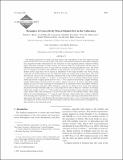| dc.contributor.author | Read, Peter L. | |
| dc.contributor.author | Yamazaki, Yasuhiro H. | |
| dc.contributor.author | Lewis, Stephen R. | |
| dc.contributor.author | Williams, Paul D. | |
| dc.contributor.author | Wordsworth, Robin | |
| dc.contributor.author | Miki-Yamazaki, Kuniko | |
| dc.contributor.author | Sommeria, Joël | |
| dc.contributor.author | Didelle, Henri | |
| dc.date.accessioned | 2016-08-15T17:33:01Z | |
| dc.date.issued | 2007 | |
| dc.identifier.citation | Read, Peter L., Yasuhiro H. Yamazaki, Stephen R. Lewis, Paul D. Williams, Robin Wordsworth, Kuniko Miki-Yamazaki, Joël Sommeria, and Henri Didelle. 2007. “Dynamics of Convectively Driven Banded Jets in the Laboratory.” Journal of the Atmospheric Sciences 64 (11) (November): 4031–4052. doi:10.1175/2007jas2219.1. http://dx.doi.org/10.1175/2007JAS2219.1. | en_US |
| dc.identifier.issn | 0022-4928 | en_US |
| dc.identifier.uri | http://nrs.harvard.edu/urn-3:HUL.InstRepos:27846859 | |
| dc.description.abstract | The banded organization of clouds and zonal winds in the atmospheres of the outer planets has long fascinated observers. Several recent studies in the theory and idealized modeling of geostrophic turbulence have suggested possible explanations for the emergence of such organized patterns, typically involving highly anisotropic exchanges of kinetic energy and vorticity within the dissipationless inertial ranges of turbulent flows dominated (at least at large scales) by ensembles of propagating Rossby waves. The results from an attempt to reproduce such conditions in the laboratory are presented here. Achievement of a distinct inertial range turns out to require an experiment on the largest feasible scale. Deep, rotating convection on small horizontal scales was induced by gently and continuously spraying dense, salty water onto the free surface of the 13-m-diameter cylindrical tank on the Coriolis platform in Grenoble, France. A “planetary vorticity gradient” or “β effect” was obtained by use of a conically sloping bottom and the whole tank rotated at angular speeds up to 0.15 rad s−1. Over a period of several hours, a highly barotropic, zonally banded large-scale flow pattern was seen to emerge with up to 5–6 narrow, alternating, zonally aligned jets across the tank, indicating the development of an anisotropic field of geostrophic turbulence. Using particle image velocimetry (PIV) techniques, zonal jets are shown to have arisen from nonlinear interactions between barotropic eddies on a scale comparable to either a Rhines or “frictional” wavelength, which scales roughly as (β/Urms)−1/2. This resulted in an anisotropic kinetic energy spectrum with a significantly steeper slope with wavenumber k for the zonal flow than for the nonzonal eddies, which largely follows the classical Kolmogorov k−5/3 inertial range. Potential vorticity fields show evidence of Rossby wave breaking and the presence of a “hyperstaircase” with radius, indicating instantaneous flows that are supercritical with respect to the Rayleigh–Kuo instability criterion and in a state of “barotropic adjustment.” The implications of these results are discussed in light of zonal jets observed in planetary atmospheres and, most recently, in the terrestrial oceans. | en_US |
| dc.description.sponsorship | Engineering and Applied Sciences | en_US |
| dc.language.iso | en_US | en_US |
| dc.publisher | American Meteorological Society | en_US |
| dc.relation.isversionof | doi:10.1175/2007JAS2219.1 | en_US |
| dash.license | LAA | |
| dc.title | Dynamics of Convectively Driven Banded Jets in the Laboratory | en_US |
| dc.type | Journal Article | en_US |
| dc.description.version | Version of Record | en_US |
| dc.relation.journal | Journal of the Atmospheric Sciences | en_US |
| dash.depositing.author | Wordsworth, Robin | |
| dc.date.available | 2016-08-15T17:33:01Z | |
| dc.identifier.doi | 10.1175/2007JAS2219.1 | * |
| dash.contributor.affiliated | Wordsworth, Robin | |


